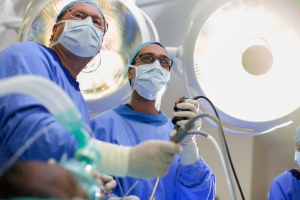Laparoscopy is a surgical procedure that helps access the inside of the abdomen and pelvis without the need for large incisions in the skin. This is a minimally invasive surgery, and specialists at Bogolyuby MC successfully use it in their practice.
When is laparoscopy used?
If possible, it is preferable to choose imaging diagnostic methods, such as ultrasound, computed tomography, magnetic resonance imaging. However, sometimes the only way to confirm the diagnosis is to directly examine the affected area using a laparoscope .
L aparoscopy is now widely used to diagnose many different conditions and investigate some specific symptoms. Indications for diagnostic laparoscopy are: inflammatory diseases of the pelvic organs; bacterial infection of the uterus, fallopian tubes and ovaries; endometriosis ; ectopic pregnancy; ovarian cyst; uterine fibroids; pain of unknown etiology in the pelvic or abdominal area.
Laparoscopy can also be used to diagnose certain types of tumors. The surgeon uses a laparoscope to remove samples of suspicious tissue for biopsy.
Laparoscopic surgery can be used to treat a number of different conditions, including: removal of an inflamed appendix (if it is in danger of rupturing); removal of the gallbladder in the presence of stones; removal of part of the intestine ; healing of peptic ulcers; surgery of tumors (ovaries, prostate, liver, colon, kidneys, bladder); treatment of ectopic pregnancy; removal of fibroids; hysterectomy ; treatment of endometriosis .
How to prepare?
Depending on the type of laparoscopic procedure being performed, the patient is asked not to drink or eat anything for 6 to 12 hours before surgery. If you are taking anticoagulants or antiplatelet agents , the medications should be stopped in consultation with your cardiologist to prevent the possible risk of excessive bleeding. It is also advisable to stop smoking, as this can slow down the healing process and increase the risk of infectious complications. The patient can be discharged from the center within a day after the intervention.
How is the procedure performed?
Laparoscopic surgery is always performed under general anesthesia.
During the intervention, the surgeon makes a small incision 1 - 1.5 cm long, usually near the navel. A small tube is inserted through the incision and carbon dioxide is pumped through it, allowing the surgeon to see the organs more clearly and have room to manipulate. Through the same tube, a laparoscope is inserted , an instrument that transmits images of the internal organs to an external monitor. At the end of the procedure, carbon dioxide is released from the abdominal cavity and the incisions are sutured.
When laparoscopy is used for diagnostic purposes, the procedure takes 30 to 60 minutes, and in the case of treatment, the time may be longer or shorter, depending on the patient's condition.
Rehabilitation period: what to expect?
After laparoscopy, the patient may feel disoriented, this is normal as this is a side effect of the anesthesia. In some cases, nausea and vomiting appear, but in general, such disorders quickly disappear. It is normal for a few days after the procedure to experience discomfort at the incision sites.
The time required to recover from laparoscopy varies greatly from one person to another. This depends on many factors, including: the purpose and reason for the intervention, general health, and any complications. In the case of diagnostic laparoscopy, rehabilitation occurs within 5 days, while in the case of treatment, the required time may increase. For example, with a laparoscopy to remove appendicitis, this can take up to two weeks, but in the case of major surgery (such as spay removal), the recovery time can be up to or exceed 4 weeks.



















